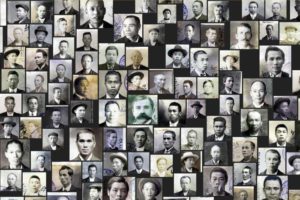Documents reveal personal stories of life under Immigration Restriction Act
A new project is aiming to dig out documentation and archival records to build a picture of the lives of people who were victims of the notorious ‘White Australia Policy’.
In place during the late 19th and early 20th centuries, the policy was designed to reinforce that notion that Australia was a white man’s country and to restrict migration to Europeans only.
However, the reality was quite different as thousands of Chinese, Japanese, Indians and Syrians all called Australia home at the time.
Many were born in Australia or had operated businesses, bought property and raised families here.
Despite that, Australians who were deemed ‘non-white’ were subject to forms of control and documentation that their fellow citizens did not have to endure.
 Now a project that is calling on members of the public to help comb through those archives records to find out the lives of these ‘non-white’ Australians.
Now a project that is calling on members of the public to help comb through those archives records to find out the lives of these ‘non-white’ Australians.
And historian Kate Bagnall is hoping the project will help with her research of Chinese Australian heritage.
She said it was important to realise Australian citizens of non-European heritage were affected by the White Australia Policy.
“We often think of it as a policy to keep new migrants out of the country, but in fact it had real implications for Australians of Asian and Middle Eastern backgrounds,” Ms Bagnall said.
“If you were a Chinese Australian — even if you were born in Australia and therefore a British subject by birth — because of the Immigration Restriction Act, you still had to apply for papers that would allow you to return to Australia without being made to sit the dictation test,” she said.
Many of the people made to prove their identity through these documents needed to travel frequently.
Visiting family was a common reason for travel, but so was doing business.
A lot of established Chinese Australians ran multinational businesses, and needed to go overseas to manage them.
But before travelling, non-white Australians had to get special documents.
Without them, they could be denied re-entry — even if they were born in Australia or had been naturalised.
Getting the certificates meant visiting the customs office, sometimes with reference letters or police reports to show they were of good character.
Photos and handprints were taken for identification, as well as written descriptions of their appearance.
All the paperwork generated under the auspices of the White Australia Policy is a rich source of information for historians.
The job now is to decrypt and analyse it.
Project organiser Tim Sherratt has built a website to do just that, and has called on people from around Australia to help out.
“The information itself is sort of locked up in those images, so our project is to transcribe those documents,” Mr Sherratt said.
Once all the handwritten documents are transcribed, more patterns and information can be found.
“To take those images and turn them into datasets for new types of exploration and discovery,” he said.
Members of the public have been visiting to help transcribe them.
See the website here: http://2017.exploringdigitalheritage.net/
One man profoundly affected by the White Australia Policy was Don Carter.
He grew up in a family divided by World War II and the colour of his parents’ skin.
His Aboriginal mother and African American father, an allied serviceman stationed in Townsville, were married, then separated after neither could migrate to their partner’s country after the war, due to racist migration policies.
Carter, who was born in 1943, grew up in Innisfail far from his mother, who worked 90 kilometres away in Cairns.
As a single mother, she worked in a ply mill and later an abattoir, travelling back every weekend to visit her only child.
”I had cousins who I grew up with but I never had anyone I could call dad,” Mr Carter said.
Mr Carter’s father was posted out a year after he married in 1941. They never met again but did exchange a series of intimate letters and photographs.
Laurie Nowell
AMES Australia Senior Journalist












